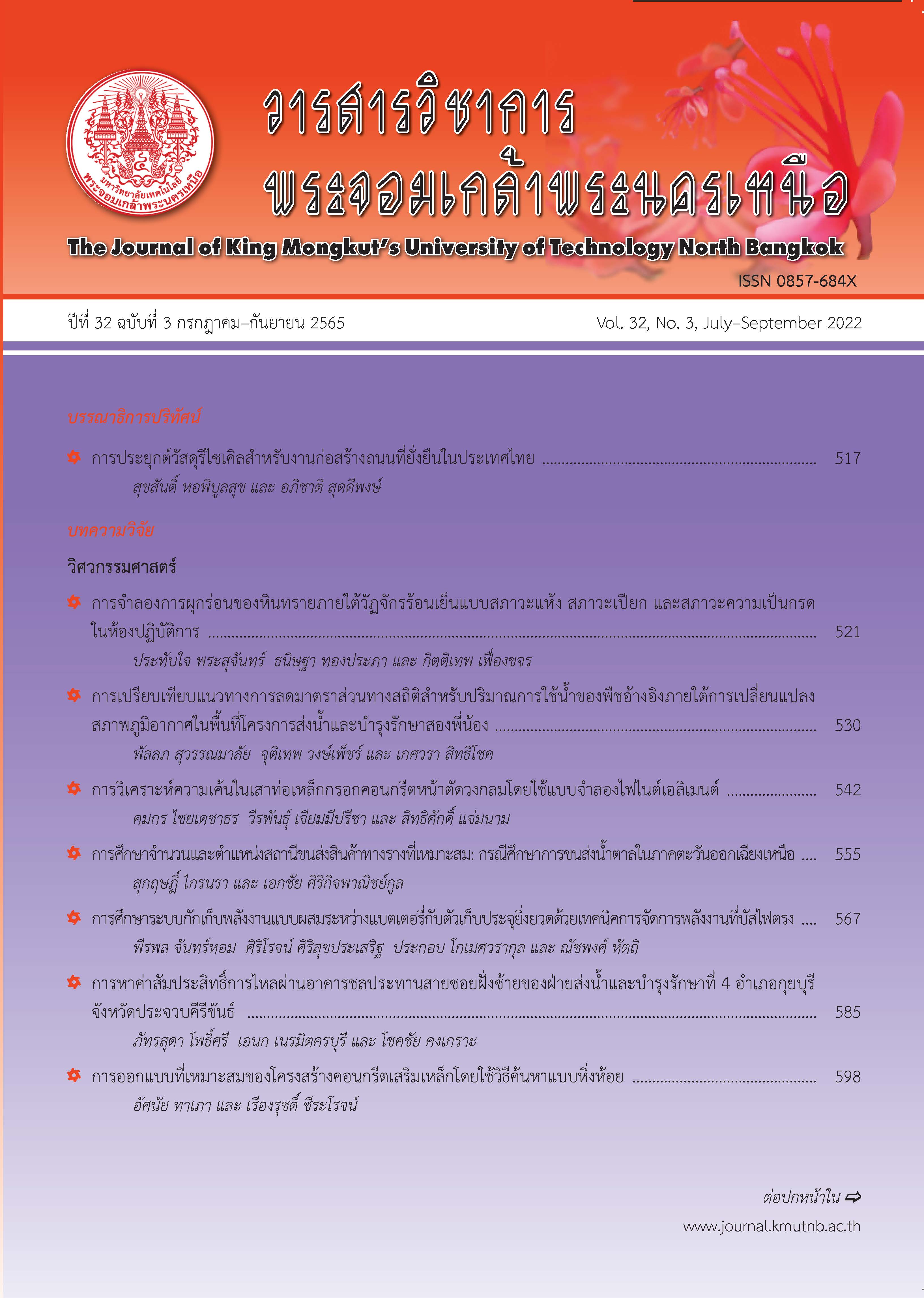อิทธิพลของการใช้กากปูนขาวจากอุตสาหกรรมผลิตเยื่อกระดาษแทนที่ปูนซีเมนต์ปอร์ตแลนด์ต่อสมบัติของคอนกรีตบล็อก
Main Article Content
Abstract
The aim of this research is to study the possibility of lime mud as Portland cement replacement materials for concrete masonry unit production. This study determined the optimal ratio of 20-80% by weight of lime mud waste replacement to compare with the replacement without lime mud with 5 formulas for making cubic blocks. The results showed that 20% by weight of lime mud waste replacement following formula B-CM yielded the maximum average density of 1,973 kg/m3, which was higher than the method without lime mud waste replacement. The next experiment results of density was 1,928 kg/m3 from C-CM formula. However, the compressive test by reducing cross sectional area with 20% and 40% by weight of lime mud waste replacement showed the maximum average compressive strength of 6.60 MPa (B-CM) and 4.02 MPa (C-CM), respectively. It can be concluded that lime mud waste partial replacement can improve the compressive strength of concrete masonry units. The results found that the average density of concrete masonry units with standard size following C-CM formula was 1,314.18 kg/m3, and the maximum average water absorption, saturation coefficient and average compressive strength were 9.4%, 10.3 and 2.27 MPa, respectively. These outcomes were found to meet the industrial standards: TIS 58-2533 for hollow non-load-bearing concrete masonry units.
Article Details

This work is licensed under a Creative Commons Attribution-NonCommercial-NoDerivatives 4.0 International License.
The articles published are the opinion of the author only. The author is responsible for any legal consequences. That may arise from that article.
References
M. B. Al-Fakih, F. Nuruddin, and E. Nikbakht, “Development of interlocking masonry bricks and its’ structural behaviour: A review paper,” Earth and Environmental Science, vol. 140, no. 1, pp. 1–9, 2018.
M. Ali, R. J. Gultom, and N. Chouw, “Capacity of innovative interlocking blocks under monotonic loading,” Construction and Building Materials, vol. 37, pp. 812–821, 2012.
M. Madrid, A. Orbe, H. Carre, and Y. Garcia, “Thermal performance of sawdust and lime-mud concrete masonry units,” Construction and Building Materials, vol. 169, pp. 113–123, 2018.
E. A. W. Hendry, “Masonry walls: Materials and construction,” Construction and Building Materials, vol. 15, no. 8, pp. 323–330, 2001.
A. Thiwongkum, “Basic properties of concrete containing strength enhancing mineral admixture” M.S. thesis, Department of Engineering, Rajamangala University of Technology Thanyaburi, 2015 (in Thai).
N. P. Rajamane, M. C. Nataraja, and N. Lakshamanan, “An introduction to geopolymer concrete,” Journal of Indian Concrete, vol. 85, no. 11, pp. 25–28, 2011.
M. E. Nazar and S. N. Sinha, “Fatigue behaviour of interlocking grouted stabilised mud-fly ash brick masonry,” International Journal of Fatigue, vol. 29, no. 5, pp. 953–961, 2007.
S. I. Fundi, I. W. Kaluli, and J. Kinuthia, “Performance of interlocking laterite soil block walls under static loading,” Construction and Building Materials, vol. 171, pp. 75–82, 2018.
W. A. M. Thanoon, A.H. Alwathaf, J. Noorzaei, M. S. Jaafar, and M. R. Abdulkadir, “Finite element analysis of interlocking mortarless hollow block masonry prism,” Computers and Structures, vol. 86. no. 6, pp. 520–528, 2008.
M. Martínez and S. Atamturktur, “Experimental and numerical evaluation of reinforced drystacked concrete masonry walls,” Journal of Building Engineering, vol. 22, pp. 181–191, 2019.
W. Homsriprasert, “Durability of fly ash-based geopolymer mortar with electric ove curing under sodium sulfate and magnesium sulfate attack,” M.S. thesis, Department of Civil Engineering, Thammasat University, 2013 (in Thai).
Y. Sommanawat, “Utilizing sludge from water treatment plant and bagasse ash as combined pozzolanic material in cellular lightweight concrete production,” M.S. thesis, Department of Environmental Technology, Mahasarakham University, 2018 (in Thai).
Phoenix Pulp and Paper Public Company Limited. (June, 2019). Environment impact assessment. [Online]. Available: http://eia.onep.go.th /projectdetail.php?id=9571
D. Chaowarat, “Utilization of lime mud from pulp and paper industry as masonry and plastering mortar,” M.E. Thesis, Environmental Engineering, Graduate School, Khon Kaen University, 2004 (in Thai).
C. Ngohpok, V. Sata, and P. Chindaprasirt, “Sound absorption of pervious concrete containing various sizes of coarse aggregate,” KKU Research Journal, vol. 19, no. 2, 65–77, 2019.
M. Maggi, A. Orbe, E. Roji, and J. Cuadrado, “The effects of by-products incorporated in low-strength concrete for concrete masonry units,” Construction and Building Materials, vol. 153, pp. 117–128, 2017.

